Published: 10th March 2022 at 4:11 am. Posted in Blog.
About Singalila National Park:
Singalila National Park is located in the Eastern Himalayan Region of India, in the state of West Bengal. It was declared a National Park in 1992 and is one of the best places to observe wild red pandas in India. This temperate cloud forest of fir, deciduous hardwoods, Rhododendron and dense bamboo is located on the Singalila Ridge at an altitude of 7000 ft to 12000 ft above sea level.
The area gets considerable seasonal monsoon rains, meaning it is perfect for a variety of weird and wonderful plants. Over 600 varieties of orchids bloom in Singalia, the largest concentration of any geographical area in the world. It is one of the most remote national parks in India, only access by foot or by the the trusty old Land Rovers left over from the British era.

An old British Land Rover
Over the border in Nepal, the same cloud forest habitat continues as Tinchule Forest. Tinchule-Singalila is one of the best places to see the elusive red panda in the world. There are an estimated 30+ red pandas in Singalila National Park. Apart from the red panda, other mammals in Singalila National park include the clouded leopard, leopard, leopard cat, Himalayan black bear, Himalayan serow, barking deer, yellow-throated marten, wild boar, pangolin, pika and much more.
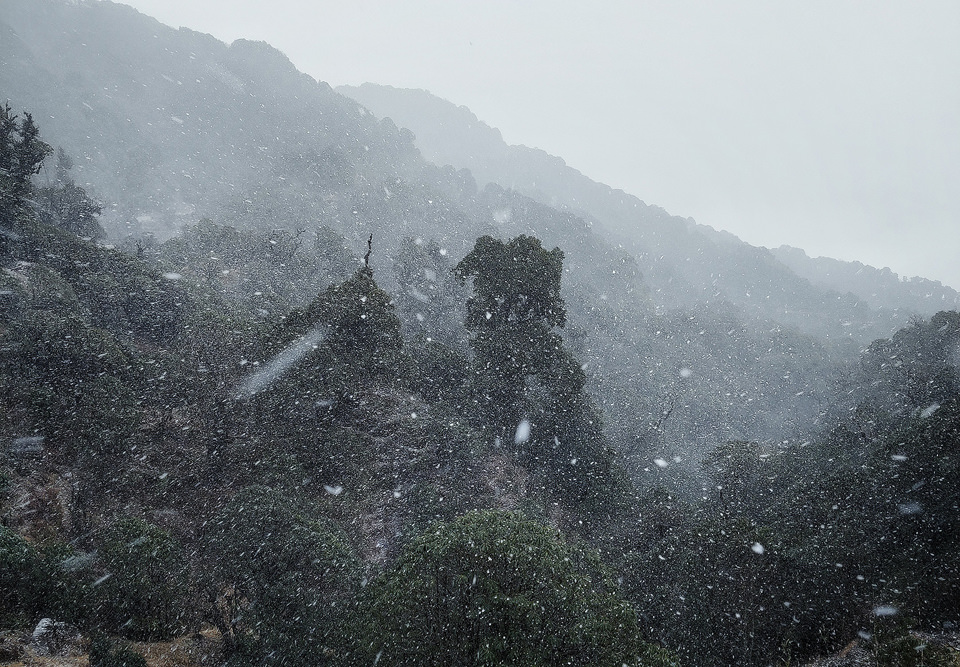
Snow fall in the Cloud forest. During the Winter Singalila is bitterly cold, regularly reaching -10 celsius.
More than 300 species of birds have been recorded in Singalila. Colourful Himalayan specialists include satyr tragopan, blood pheasants, kalij pheasants, fire-tailed myzornis, yellow-billed blue magpie, golden-breasted fulvetta, Himalayan bluetail and many more.
Red Pandas:
The red panda (Ailurus fulgens) is an arboreal mammal native to the eastern Himalayas and southwestern China. It is the only living member of the genus Ailurus. Red pandas have reddish-brown fur, a long striped tail, and distinctive facial markings which can be used to identify individual pandas. Their thick fur is double layered and highly water resistant, perfect for dealing with the harsh Himalayan climate.
Red pandas prefer to spend their entire time in the tree canopy and look uncomfortable when on the ground thanks to their a waddling gait due to their short front legs. They sleep in trees and even get their water by licking water from the moss. They do not even descend to defecate, instead using latrines high up in the tree canopy. This specialisation helps them to avoid large predators such as the clouded leopard.
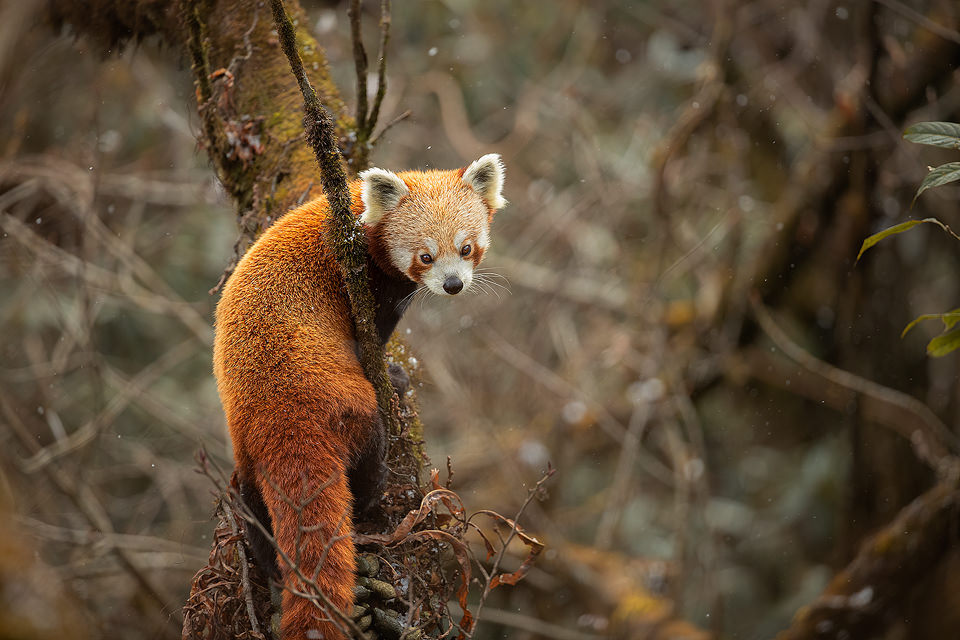
Red Panda looking back towards the camera with flakes of falling snow
Despite being classed as a carnivorous animal, red pandas feed primarily on bamboo. The abundance of bamboo in the forest understory and their strong sharp semi-retractile claws, perfect for grasping narrow tree branches, help them to avoid competition for food with other omnivores. Red pandas can only digest approximately 25% of the nutrients found in bamboo, so they have to consume around 20,000 bamboo leaves a day!
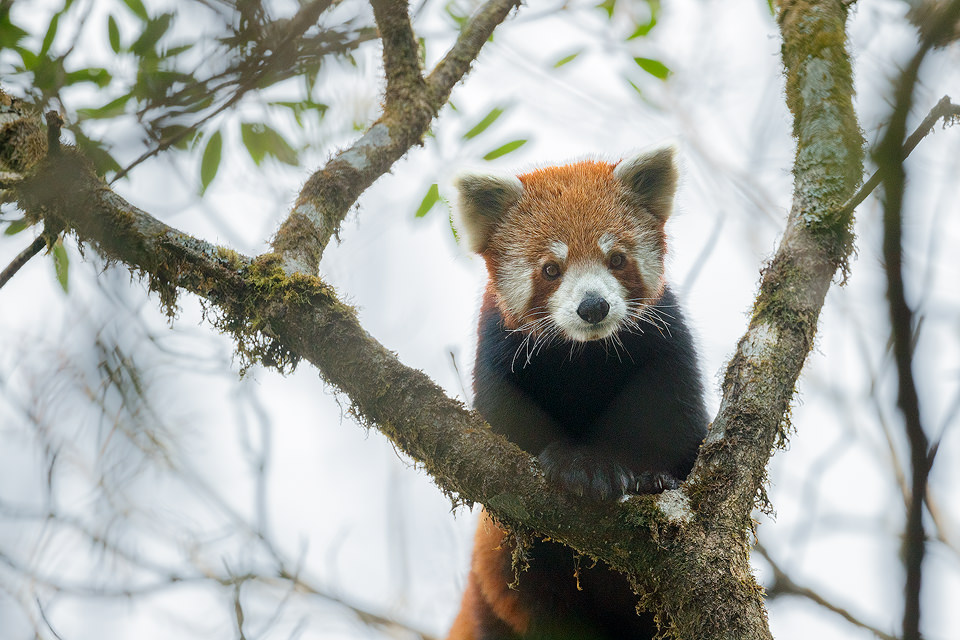
Red pandas are primarily nocturnal animals, active from dusk to dawn and sleeping during most of the day. Due to their fast metabolism they have to eat every 4-5 hours, so they prefer to stay close to their favourite food, bamboo. Red pandas also eat flowers, fruits, insects, birds and their eggs.
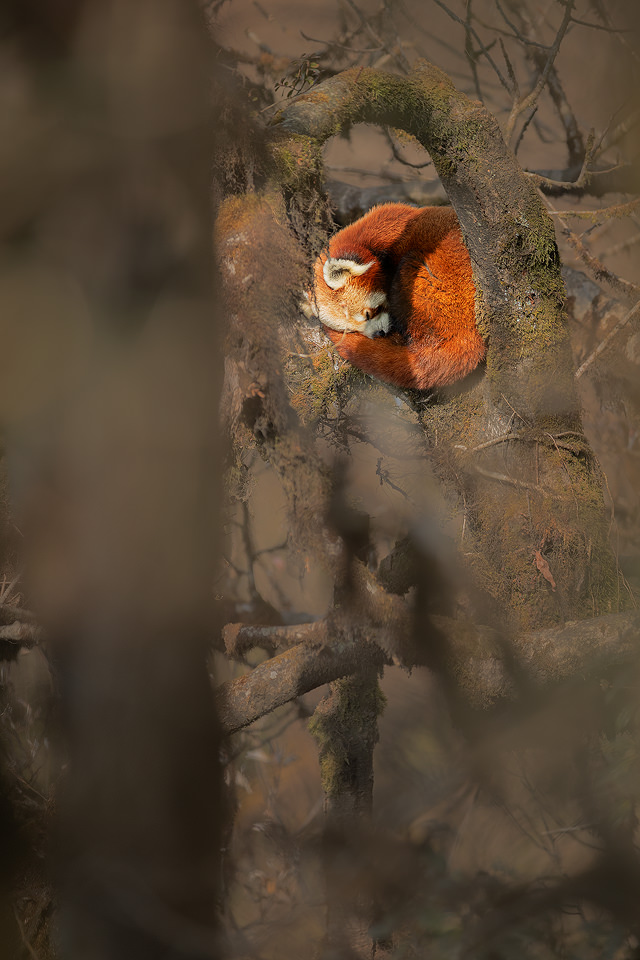
Red pandas are primarily nocturnal animals, active from dusk to dawn and sleeping during most of the day.
Red pandas are solitary animals, only seen in groups following the winter breeding season. Female red pandas are receptive for just one a day in a year and give birth to 1-4 cubs. The cubs stay with their mother for up to 2 years, however sadly only 50% of the cubs survive in the wild.
Despite their name, red pandas are not closely related to the giant panda and are in fact the only ‘true’ panda. Giant pandas are actually part of the bear family, Ursidae. One similarity they do share with giant pandas is their “false thumb”, which is actually an extension of the wrist bone. When descending a tree head-first, they are able to rotate their joints to control their descent.
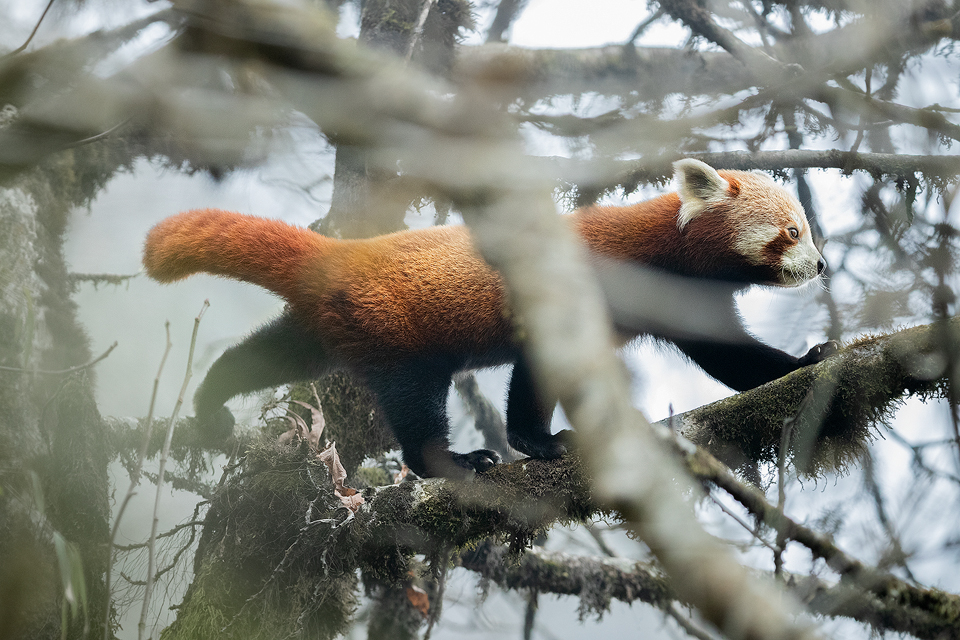
Red Panda traversing the dense forest canopy. Singalila National Park, West Bengal, India.
These charismatic Himalayan specialists have survived for millions of years thanks to their extraordinary survival strategies, however they are now on the brink of extinction. It is estimated that less than 3000 red pandas exist in the wild. This figure continues to decline due to habitat loss and fragmentation, poaching, and lack of genetic diversity due to inbreeding. The small fragmented populations and continued decline mean that they are listed as endangered on the IUCN Red List.
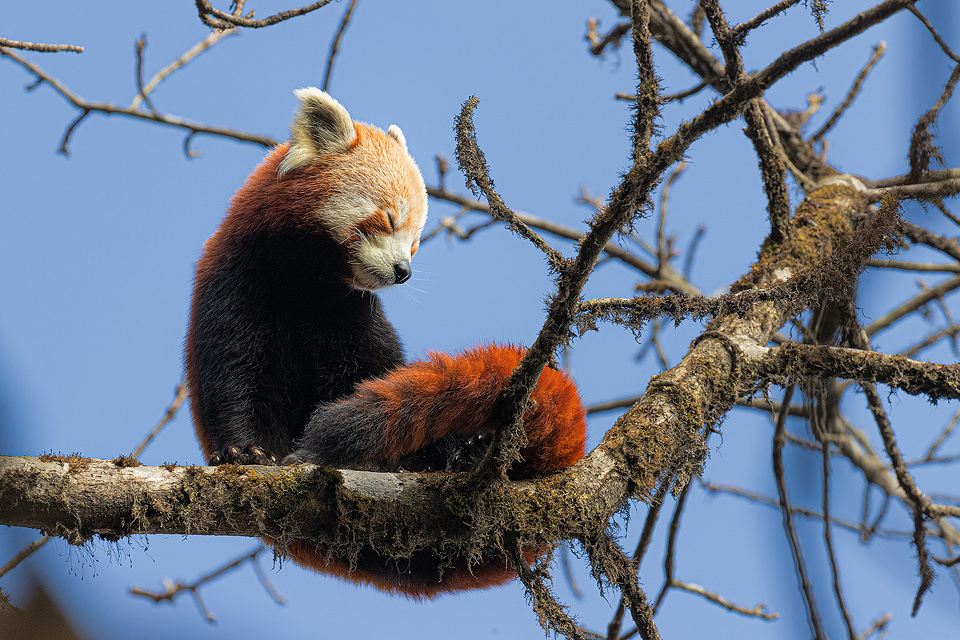
Stretching red panda against a bright blue sky.
Sandakhphu
Singalila is well known for the steep rocky trekking route to Sandakphu that runs through it. Sandakphu is an incredible place to watch sunrises and sets, Sandakhphu summit is situated within Singalila National Park and is the highest peak in West Bengal. Sandakphu offers incredible views of four of the worlds five highest mountains; Mt Everest (8848 m) Kangchenjunga (8586 m), Lhotse (8516 m) and Makalu (8485 m).
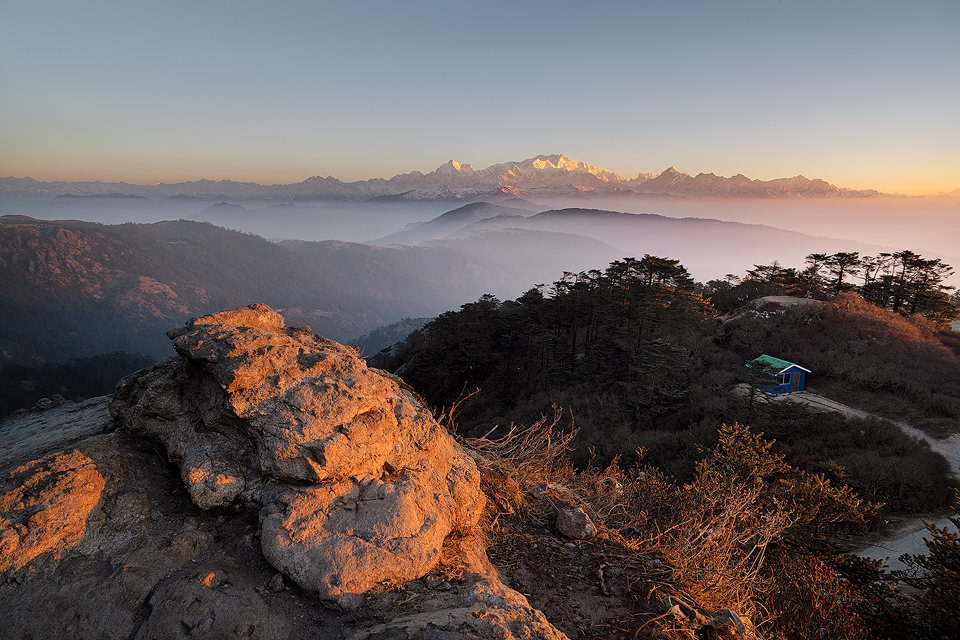
The highest point at Sandakphu, looking towards the Kanchenjunga range. West Bengal, India.
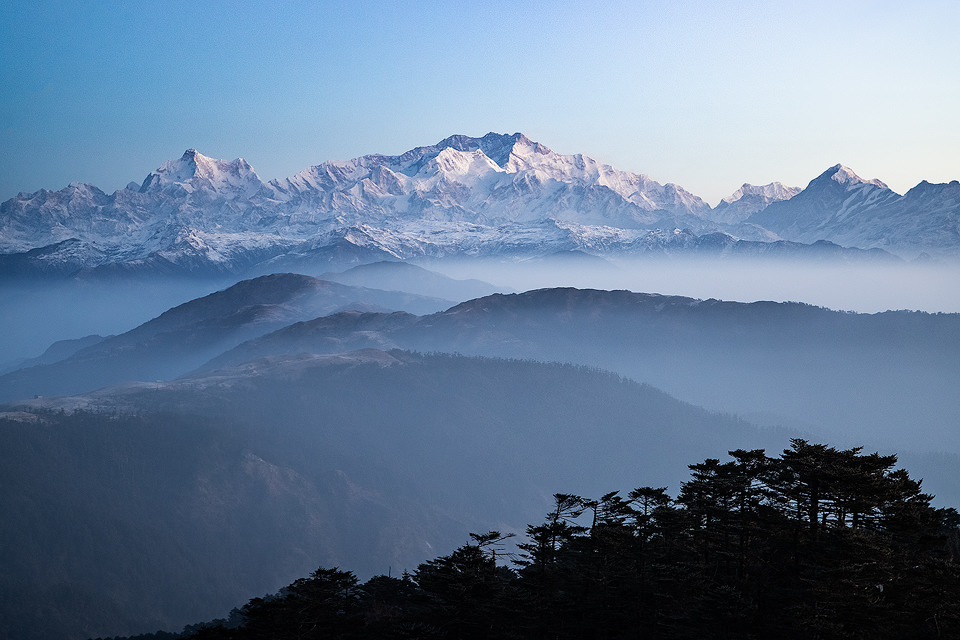
Kangchenjunga Range, otherwise known as the Sleeping Buddha (8586 m).

Lhotse (8516 m), Mt Everest (8848 m), Makalu (8485 m) and Chomo Lonzo (7540 m).

